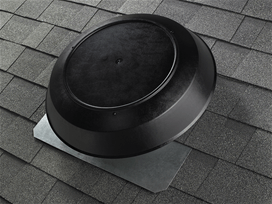Attic Ventilation
Attic ventilation is essential in making any home more comfortable while lowering energy costs. Air-conditioners can run less and won’t have to work as hard. Humid, stagnant air can be removed, drawing fresh dry air across the surfaces. Your attic can be drier and cooler – the perfect tools to help fight potential moisture damage. Attics get hot because your roof takes the full brunt of the Sun’s energy. As the Sun beats down on your roof, the shingles heat up – reaching temperatures up to 150°F. This heat is transferred through the shingles, to the roof deck, to the lumber and rafters, and to anything else inside the attic. All of these materials will absorb and radiate the heat.

Remove damaging moisture from attic.
Cool evening air can create condensation that collects on insulation and wood during the summer. In the winter, moisture escaping from the home’s living space can condense in the attic on wood and insulation, which can lead to damaging rot and costly repairs. Wet insulation loses its effectiveness and can cultivate mold or mildew, cause stains or crumbled ceilings. A properly ventilated attic helps remove harmful moisture.
Attic fans are intended to cool hot attics by drawing in cooler outside air from attic vents (soffit and gable) and pushing hot air to the outside. However, if your attic has blocked soffit vents and is not well-sealed from the rest of the house, attic fans will suck cool conditioned air up out of the house and into the attic. This will use more energy and make your air conditioner work harder, which will increase your summer utility bill.
